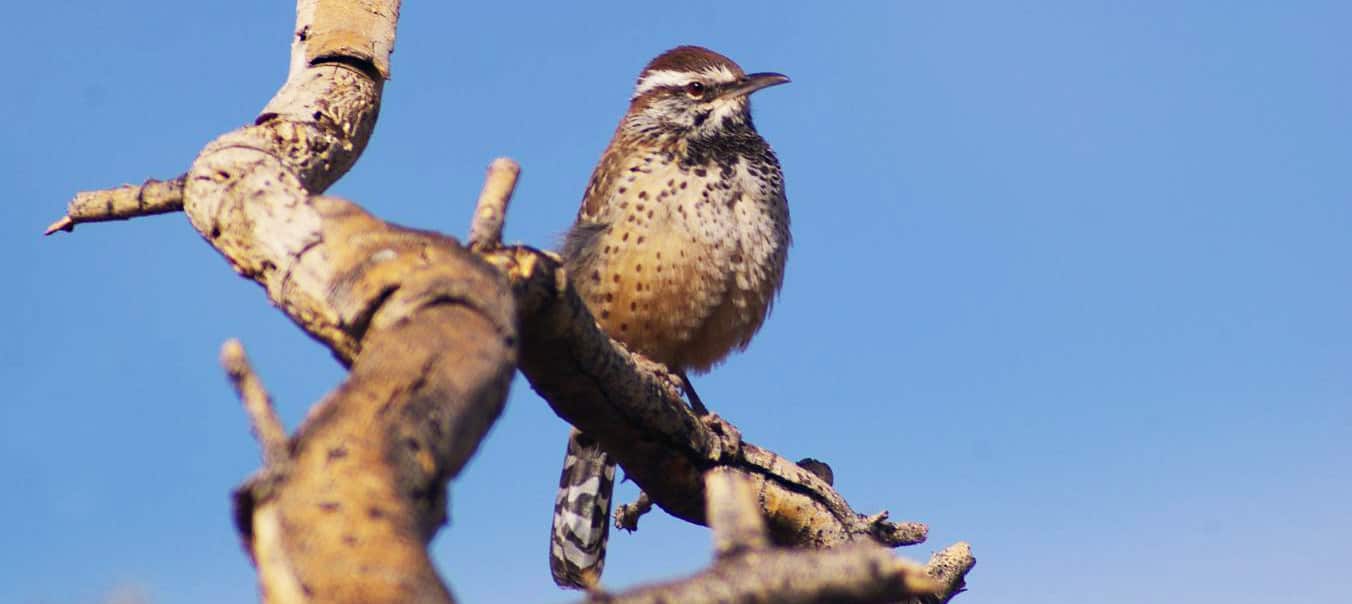Share this article
Desert-friendly yards help local birds in arid cities
The pressures of big city living may take a toll on native desert bird species, but keeping a more drought-tolerant yard may help them keep a toehold in cities like Phoenix despite the houses, traffic and humans.
“That’s a potential avenue for retaining these species over time,” said Paige Warren, a professor of environmental conservation at the University of Massachusetts Amherst and the lead author of a study published recently in Ecosphere.
This research follows a study conducted five years ago in Phoenix that evaluated whether people had more drought-tolerant vegetation in their yards or whether they had a more classic green lawn in need of a lot of water. They found that whole neighborhoods were often characterized by one or the other type of vegetation, and that there was a strong correlation between bird diversity and which type of yard was present. Native species tended to favor desert-like yards that somewhat resembled the natural habitat outside the city. This happened even though some of the flora in the drought-tolerant yards weren’t actually native.
Socioeconomic differences among neighborhoods are also tend to correlate with bird diversity.
“We found over and over again that wealthy parts of the city have more native bird species,” Warren said.
Phoenix residents also tended to be more satisfied about the birds around their homes when their yards were more natural.
“Things that we do for birds can also be beneficial for people,” Warren said. “Places where birds are happy are also places where people are happy whether that’s because of the birds or not.”
Recently they repeated the study, and had similar findings regarding native species preferring desert-like yards and the socioeconomic correlation between people and bird diversity. But bird numbers and diversity had dropped across the board on average since the last study five years earlier.
“The same kinds of species are there, but we’re finding fewer of them, and the specialist desert species were becoming more less prevalent across the city in general,” Warren said. The declines contrasted with the populations of these bird species in wilder areas, where they are relatively stable.
Native birds in decline included some species of concern in North America like the verdin (Auriparus flaviceps), which is also a pollinator, and the curve-billed thrasher (Toxostoma curvirostre).
While the reasons for this decline are uncertain, Warren speculates that it might be due to accumulated pressure on these populations from pollution, noise disturbance, changes in food resources or other problems.
“Our big concern in terms of this change is that we might be seeing kind of a lag effect. The city grew rapidly, and birds were able to hang out there for a while, but these accumulated stressors of urbanization might be making it too hard for these populations to persist over time,” she said.
Even generalist species were declining, she said, but encouraging more people to keep desert-like yards could help counteract the effects.
“If you can add some shrubs and native plants in your yard, that will probably go a long way towards having some more bird diversity in your area,” Warren said.
While this study was conducted in Phoenix, past research shows allowing native plants to grow in your yard can help native species in other areas as well. Susannah Lerman, a research ecologist at the U.S Forest Service’s Northern Research Station and one of the coauthors on this desert bird study also was behind a study that found that being a lazier lawnmower made yards a healthier habitat for native bees.
“This study is part of a larger effort to understand how households can contribute to providing habitat for native species. Our landscaping choices and behaviors can have a profound and positive impacts on suburban wildlife,” Lerman said.
Aside from the importance to native birds in Phoenix, Warren and Lerman also found people are more satisfied when birds congregate in their desert-like yards — something less common in less affluent areas.
“Something that’s really important is to think about how to provide equal access to nature experiences in the city,” Warren said.
Header Image: Researchers found that bird abundance and species numbers decreased over time in areas where homeowners provided desert landscaping. ©Eyal Shochat/Ben Gurion University of the Negev








